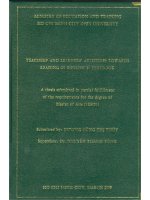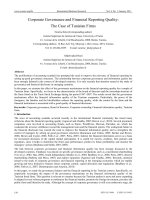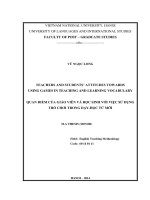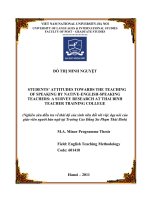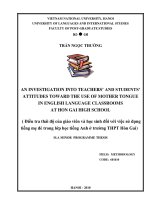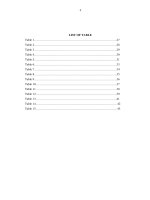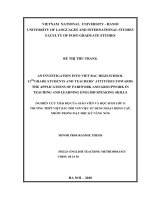Teachers’ and students’ attitudes towards the piloted textbook english 10 the case of nghia hung upper secondary school, nam dinh city
Bạn đang xem bản rút gọn của tài liệu. Xem và tải ngay bản đầy đủ của tài liệu tại đây (603.91 KB, 62 trang )
VIETNAM NATIONAL UNIVERSITY, HANOI
UNIVERSITY OF LANGUAGES AND INTERNATIONAL STUDIES
FACULTY OF POST- GRADUATE STUDIES
HOÀNG THỊ CÚC
TEACHERS’ AND STUDENTS’ ATTITUDES TOWARDS THE PILOTED
TEXTBOOK ENGLISH 10: THE CASE OF NGHIA HUNG UPPER
SECONDARY SCHOOL, NAM DINH CITY
THÁI ĐỘ CỦA GIÁO VIÊN VÀ HỌC SINH ĐỐI VỚI SÁCH GIÁO KHOA
TIẾNG ANH 10 THÍ ĐIỂM: NGHIÊN CỨU TẠI TRƯỜNG TRUNG HỌC
PHỔ THÔNG NGHĨA HƯNG A TỈNH NAM ĐỊNH
M.A. Minor Programme Thesis
FIELD: Theory and Methodology of Teaching English
CODE: 60140111
HÀ NỘI - 2017
VIETNAM NATIONAL UNIVERSITY, HANOI
UNIVERSITY OF LANGUAGES AND INTERNATIONAL STUDIES
FACULTY OF POST- GRADUATE STUDIES
HOÀNG THỊ CÚC
TEACHERS’ AND STUDENTS’ ATTITUDES TOWARDS THE PILOTED
TEXTBOOK ENGLISH 10: THE CASE OF NGHIA HUNG UPPER
SECONDARY SCHOOL, NAM DINH CITY
THÁI ĐỘ CỦA GIÁO VIÊN VÀ HỌC SINH ĐỐI VỚI SÁCH GIÁO KHOA
TIẾNG ANH 10 THÍ ĐIỂM: NGHIÊN CỨU TẠI TRƯỜNG TRUNG HỌC
PHỔ THÔNG NGHĨA HƯNG A TỈNH NAM ĐỊNH
M.A. Minor Programme Thesis
FIELD: Theory and Methodology of Teaching English
CODE: 60140111
SUPERVIOR: Hoàng Thị Xuân Hoa, PhD
HÀ NỘI - 2017
i
CANDIDATE’S STATEMENT
I certify that the minor thesis entitled: “Teachers’ and students’ attitudes
towards the piloted textbook English 10: The case of Nghia Hung Upper Secondary
School, Nam Dinh City.” is submitted in partial fulfillment of the requirements for the
degree of Master of Arts is the result of my own work, except where otherwise
acknowledge and that this minor thesis or any part of the same had not been submitted
for a higher degree to any other universities or institutions.
Date:…….…………………………….
Signature:..……………………………
ii
ACKNOWLEGDEMENTS
During the process of writing this thesis, I have been fortunate to receive
supports and assistance from a variety of people.
First and foremost, I wish to express my deepest gratitude to my supervisor, Dr.
Hoang Thi Xuan Hoa, who allows me to draw fully on her wisdom and experience in
implementing this study. Her guidance, encouragement and invaluable detailed critical
feedback have been most generous.
I would like to convey my thanks to all my teachers of the Post graduate course
22 whose fundamental knowledge about language teaching and learning is of great
importance to the achievement of my academic study.
My heartfelt gratitude is also to the English teachers and students of Nghia
Hung Upper Secondary School for their tremendous supports in the collections of data
and information for my study.
Finally, I wish to express my acknowledgments to other individuals who have
indirectly contributed to the completion of this thesis.
To all these people I only hope that the achievement of my thesis will be
favorable enough to satisfy their expectation.
iii
ABSTRACT
The textbook is an useful tool for teaching and learning second language and
one of the most important components of any educational environment that lead to
success or failure of the teaching and learning language. This is especially true a
Nghia Hung A Upper Secondary School where English teachers and students use the
piloted textbook English 10 in the course. Also, the role of the teachers‟ and students‟
attitudes affects teaching and learning second language. According to Karahan (2007),
“positive language attitudes let learner has positive orientation towards learning
English” (p.84). Gardner, Masgoret, Tennant & Mihic (2004) claim that attitudes
influence language learning. As such, attitudes play a crucial role in language learning
because they would influence students‟ and teachers‟ failure or success in their
teaching and learning. Gardner and Lambert (1972) in their studies give evidence that
positive attitudes toward language enhance proficiency. It is also believed that positive
attitudes alleviate language learning whereas negative attitudes act as s psychological
barrier against it. This study is therefore conducted with the hope to investigate the
teachers‟ and students‟ attitudes towards the piloted textbook English 10. The study
was conducted with 2 teachers and 80 students at 10T1 and 10T2-Nghia Hung A
Upper Secondary School. The data was collected through interviews, observations and
questionnaires to find out the attitudes of teachers and students towards the piloted
textbook.
The findings reveal that most of teachers and students have positive attitudes
towards the topic and contents, the vocabulary, grammar and pronunciation, the
physical appearance and the social cultural contexts of the piloted textbook, they have
however negative attitudes towards the language contents. The findings also show that
the teachers‟ and students‟ positive attitudes, knowledge and background are
necessary components affecting to the teaching and learning the piloted textbook
English 10.
iv
LIST OF ABREVIATIONS
MOET:
Ministry of Education Training
L2:
Second Language
EFL:
English as a Foreign Language
ESL:
English as a Second Language
v
LIST OF TABLES
Tables:
Table 1: The attitudes of students towards the topic and the content of the piloted
textbook English 10. ..................................................................................................... 25
Table 2: The attitudes of students towards the vocabulary, grammar and
pronunciation of the textbook ....................................................................................... 26
Table 3: The attitudes of students toward language contents of the textbook ............. 27
Table 4: The attitudes of students towards the physical appearance........................... 28
of the textbook. .............................................................................................................. 28
Table 5: The attitudes of students towards social and cultural contexts of the textbook. ......... 29
Table 6: The attitudes of students’ towards teaching methods. ................................... 29
Charts:
Chart 1: The students’ preferences toward the piloted textbook English 10. ............. 30
Chart 2: The beliefs of the students about the students’ proficiency toward the textbook. .......... 30
vi
TABLE OF CONTENTS
CANDIDATE’S STATEMENT ................................................................................... i
ACKNOWLEGDEMENTS ......................................................................................... ii
ABSTRACT .................................................................................................................iii
LIST OF ABREVIATIONS ........................................................................................ iv
LIST OF TABLES ........................................................................................................ v
TABLE OF CONTENTS ............................................................................................ vi
PART I: INTRODUCTION ........................................................................................ 1
1. Rationale of the study .............................................................................................. 1
2. Aims of the study ..................................................................................................... 2
3. Research questions ................................................................................................... 2
4. Scope of the study .................................................................................................... 2
5. Significance of the study.......................................................................................... 3
6. Methodology ............................................................................................................ 3
6.1. Data collection ...................................................................................................... 3
6.2. Data analysis ........................................................................................................ 4
7. Design of the study .................................................................................................. 4
PART II: DEVELOPMENT ...................................................................................... 6
CHAPTER I: LITERATURE REVIEW ........................................................................ 6
1. Attitudes in teaching and learning foreign language. .............................................. 6
1.1. Definition of attitude ............................................................................................. 6
1.2. Components of attitude ......................................................................................... 8
1.2.1. Behavioral Aspect of Attitude .......................................................................... 10
1.2.2. Cognitive Aspect of Attitude............................................................................. 10
1.2.3. Emotional Aspect of Attitude ........................................................................... 11
1.3. The roles of attitudes in language learning ......................................................... 11
2. The textbook in teaching and learning language ................................................... 12
2.1. Definition of the textbook ................................................................................... 12
2.2. The roles of a textbook ....................................................................................... 13
2.3. The roles of a textbook in language learning ...................................................... 14
vii
3. Related Studies....................................................................................................... 15
CHAPTER 2: RESEARCH METHODOLOGY .......................................................... 18
1. Practical situation of teaching and learning the piloted English 10 in Nghia Hung
Upper Secondary School............................................................................................ 18
1.1. Description of the English course and its objectives at Nghia Hung Upper
Secondary School....................................................................................................... 18
1.2. Description of the students at Upper Secondary School .................................... 19
1.3. Description of the teachers at Nghia Hung Upper Secondary School. ............... 20
2. Overview of the textbooks ..................................................................................... 20
3. The Study ............................................................................................................... 21
3.1. Participants .......................................................................................................... 21
3.2. The Data Collection Methods ............................................................................. 21
3.2.1. The questionnaire............................................................................................. 21
3.2.2. The interview .................................................................................................... 22
3.2.3. The observation ................................................................................................ 22
3.3. Data collection and data analysis procedures ..................................................... 23
3.3.1. Data collection procedures .............................................................................. 23
3.3.2. Data analysis procedures ................................................................................ 24
4. Conclusion ............................................................................................................. 24
CHAPTER 3: DATA ANALYSIS AND DISCUSSIONS .......................................... 25
1. Data analysis .......................................................................................................... 25
1.1. Data analysis of questionnaire ............................................................................ 25
1.2. Data analysis of the interview ............................................................................. 31
1.2.1. Teachers’ response .......................................................................................... 31
1.2.2. Students’ response ........................................................................................... 34
1.3. Data analysis of classroom observation .............................................................. 35
2. Findings.................................................................................................................. 37
3. Discussion .............................................................................................................. 41
PART III. CONCLUSION AND RECOMMENDATIONS ................................... 43
1. Implications............................................................................................................ 43
2. Limitations of the study ......................................................................................... 43
viii
3. Suggestions for further researches ......................................................................... 44
4. Conclusion ............................................................................................................. 44
REFERENCES ........................................................................................................... 45
APPENDICES ................................................................................................................I
APPENDIX 1 ..................................................................................................................I
APPREDIX 2 ................................................................................................................. V
APPREDIX 3 ................................................................................................................. V
1
PART I: INTRODUCTION
1. Rationale of the study
It is argued that language learning is regarded as the cornerstone of human
existence. Knowing the language can help people to express their opinions, hopes,
and even their dreams (Tavil, 2009). In recent years, English has become a
compulsory subject for the students in all school levels, which urges the educators
and the researchers to find out ways of teaching and learning effectively. There are
some factors affecting teaching and learning foreign language such as personal
characteristics, disposition, the background of the teachers and students, the
difficulty of the language, the lack of the instruction media and facilities to teach the
English language the appropriate classroom environments, the content of the
English course, and the teachers' satisfaction with their job as EFL teachers, etc. In
foreign language learning context, there are various factors that influence the
teaching and learning process such as motivation, attitudes, anxiety, learning
achievements, aptitudes, intelligence, age, personalities, etc. (Gardner, 1960;
Lehmann, 2006, cited in Shams, 2008). The attitudes of teachers and students have
a strong impact on the success or failure of teaching and learning language.
Attitudes had a strong impact on teaching and learning language, which affects the
success or failure of teachers and learners. Also, the textbook also played an
important role in teaching and learning, it provides the framework for teachers and
learners in achieving the aim of the course. In fact, there are no studies about the
piloted textbook English 10. Hence, the study looks into the concept of attitude as
one of the major affective factors for success in teaching and learning a foreign
language. Therefore, this research focused on the attitudes of teachers and learners
towards the piloted textbook English 10.
Being a teacher of English in Upper Secondary School, I realize that the
attitudes of the teachers and students towards the piloted textbook could affect the
results of teaching and learning the language. Hence, I would like to do an
2
investigation with a hope to elucidate the roles of attitudes in teaching and learning
L2 so that I have carried out the study entitled:
Teachers’ and students’ attitudes towards the piloted textbook English 10:
The case of Nghia Hung Upper Secondary School, Nam Dinh City.
2. Aims of the study
The present study aims to investigate the attitudes of the teachers and
students in the piloted textbook English 10.
The following were the objectives of this study:
- To find out the teachers‟ and students‟ attitudes towards the piloted
textbook English 10.
- To find out the feelings of teachers and students in the classroom toward
the piloted textbook English 10.
3. Research questions
To order to achieve the above purposes in the research, there are 2 questions in the
research:
(i).What are the attitudes of the teachers towards the teaching of the piloted
English 10?
(ii).What are the attitudes of the students towards the learning of the piloted
English 10?
4. Scope of the study
The new piloted English 10 textbook is not common because it is the piloted
program in the small extent of the quantity of the schools and the subjects in the
piloted program, so the study will focus on the attitudes of teachers and students
towards the piloted textbook. However, this study only focuses on the attitudes of
teachers and learners towards employing the piloted textbook English 10,
particularly with 80 students and 5 teachers chosen for this program at Nghia Hung
3
Upper Secondary School. Therefore, it cannot be said that the result of the study are
generalized to all students and teachers who piloted this new textbook.
5. Significance of the study
One of the major theoretical issues that have been paid attention to is the
attitudes of teachers and students because they affect to the behaviors and responses
of the teachers and students. According to Ajzen and Fishbein (1980), attitudes
exert a direct influence on behavior. An individual‟s attitudes towards something
will influence his or her overall patterns of responses to it. The study was conducted
with the expectation that its results would be useful for the teachers and students.
Firstly, a deeper understanding of teachers‟ and students‟ attitudes towards teaching
and learning the piloted English 10 textbook will be gained. Secondly, the results
from this study can help teachers‟ and students‟ attitudes toward teaching and
learning language. Thirdly, the information from the study can benefit teachers and
students conceive the need to develop positive attitudes toward teaching and
learning second language and control the attitudes to achieve the effectiveness of
language teaching and learning.
6. Methodology
6.1. Data collection
In the research of language attitude, two theoretical approaches are used and
they are „behaviorist view‟ and „mentalist view‟ (Fasold, 1984). According to
behaviorist view, the attitudes are dependent variables which must be studied by
observing users‟ responses to certain languages, i.e. their use in actual interactions
whereas according to mentalist view, attitudes are internal mental state which
cannot be observed directly but have to be inferred from users‟ behavior or their self
-reported data. The cognitivists (metalists) maintain that learning cannot be equated
with behavior because observed behavior is only the outward manifestation of
internal changes, which the organism may have undergone as a result of learning,
4
and these internal changes are not in themselves observable. The behaviorist theory
emphasizes the importance of verbal behavior and operates the principle:
behaviorist theory is the habit formation theory of language teaching and learning.
This research will use 3 methods to collect the data: observation, and
questionnaires, interviews. Classroom observation is useful to researchers in a
variety of ways, which provides researchers to check for nonverbal expression of
feelings, determine who interacts with whom, grasp how participants communicate
with each other, and check for how much time is spent on various activities.
Interviews may be useful ad follow-up to certain respondents to
questionnaires. The questionnaire is one of the most common methods of gathering
data. It is also time-saving and conductive to reliable results. Data were collected by
means of survey questionnaires for 80 students at Nghia Hung Upper Secondary
School. The questionnaires included closed- ended questions, open- ended
questions. Other sources for data collection came from classroom observation, an
interview two teachers and 10 students.
6.2. Data analysis
To order to fulfill the task mentioned above, this study will employ two
approaches of data analysis: quantitative and qualitative methods. The quantitative
method is used to collect data through survey questionnaire; the qualitative method
is used to gather information through informal interviews and observation from
teachers and students in the classroom.
7. Design of the study
The thesis consists of three parts:
Part one is the INTRODUCTION which presents the rationales, the
objectives, the method and the design of the study. It expresses the reason why the
author decided to choose this study and the methods for the fulfillment of the study.
Part two, DEVELOPMENT, includes three chapters.
5
Chapter One deals with a historical overview of literature. It starts with the
theoretical issues on attitudes of teachers and students towards the piloted textbook,
which consist the definition, components of attitudes, the relationship among
perception, belief and attitude, the relationship between attitude and motivation, the
roles of attitudes in language learning, language attitude in teaching and learning in
the piloted curriculum. The next part discusses about the definition of textbook, the
roles of the textbook in teaching and learning L2.
Chapter Two emphasizes the study methodology. Also, in this chapter the
author would like to provide some information about the findings of the study.
Chapter three suggests some recommendations to improve the teaching and learning
the piloted English 10.
Part three, CONCLUSION, summarizes the thesis with key issues in the
study, makes some suggestions for further study.
6
PART II: DEVELOPMENT
CHAPTER I: LITERATURE REVIEW
1. Attitudes in teaching and learning foreign language.
1.1. Definition of attitude
Attitude has recently received considerable attention from both first and
second language researchers. It is defined within the framework of social
psychology as a subjective or mental preparation for action. It defines outward and
visible postures and human beliefs. It determines what each one will see, hear,
think, and do. Attitude in Longman Dictionary of Language Teaching and Applied
Linguistics written by Richards (2002) is defined as, expressions of positive or
negative feelings towards a language. These expressions may reflect impressions of
linguistic difficulty or simplicity, ease the difficulty of learning, degree of
importance, elegance, social status, etc.
Attitude is an important concept which is defined as a complex mental state
involving beliefs and feelings. Attitude has also been defined as a mental and
neutral state of readiness, organized through experience, exerting a directive or
dynamic influence upon the individual‟s response to all objects and situations with
which it is related. Furthermore, attitude means the individual‟s prevailing tendency
to respond favorably or unfavorably to an object (Morries and Maisto,2005).
According to Hallorah( 1967), attitudes represents an individual‟s like and dislike of
an item. Attitudes are positive, negative and neutral views of an “attitude object” i.e.
a teaching style, person, situation or event. People mean that they simultaneously
possess a positive and a negative bias towards the attitude in question. In Gibb‟s
opinion (1988) attitude is generally defined as a state of mind, which is influenced
by feelings, experiences of the world and belief. And the attitudes and behavior of
teachers toward their profession can be portrayed in a positive or negative way
which can have an effect on the achievement of the students. Both negative and
positive attitudes have a strong impact on the success of language learning and
teaching. This means when teachers with positive attitudes experience success in
7
the language teaching behavior, the attitudes are reinforced, whereas teachers with
negative attitudes may fail to progress language teaching. In short, attitudes have a
strong impact in teaching and learning language, which affects the success or failure
of teachers and students.
There is close ties among belief, perception and attitude. According to
Richard R. Bootzin, Gordon H. Bower, Elizabeth Hall (1991), belief and perception
are just inside the brain, they are not in action. Belief is the root or foundation of a
person‟s way of thinking. In normal life, people do not question or filter their belief.
They take their beliefs as it is. Perception is the method or way of thinking or point
of view. Attitude is what people act or react. How people perform their thinking is
their attitude. Their action is depending on their attitude. They usually do not see
their own action. Their action is just a show-off of their perception and their belief.
In summary, three components has a close relationship, they can influence others
through their own change in attitude, their action or the reaction. They are valuable
that help the researchers develop the aims of the study.
Attitudes and motivation play a primary role on language learning situations
and in second language acquisition contexts. Therefore, attitudes and motivation are
the most important determinant factors in the learning or acquisition of second
language. Gardner (1985:9-12) makes clear distinctions between two terms:
Attitudes are considered to show an evaluative reaction to some referent (e.g. the
teacher, the EFL classroom, the textbook,…) inferred on the basis of the learner‟s
beliefs X the referent ( e.g. opinions, feelings, emotional reactions, etc.). Attitudes
contain three basic factors:
- cognitive: the learner‟s belief structure
- affective: affective reactions
- conative: tendency to behave in a certain way
Motivation contains favorable attitudes. As used by Gardner, it is a
combination of effort, desire and positive attitudes towards the learning of the
8
second/ foreign language. It includes: effort, want, affect on the one hand and it is
also goal directed (cognitive component).
In learning a second language, it is important that students have high
motivation and positive attitude towards the target language. This is because many
linguists have proven that motivation and attitude are closely related in determining
the success of second language learning (Gardner & Lambert, 1972). Higher levels
of motivation and positive attitude will produce more successful language learners
and vice versa. Brown (2000) states that a language learner benefits from positive
attitude and that negative attitude may lead to decrease in motivation; and
consequently it leads to unsuccessful attainment of proficiency.
1.2. Components of attitude
Most researchers stated that attitudes of teachers and students are an integral
part of teaching and learning language, therefore, it becomes an essential
component of second language learning pedagogy. There are three components of
attitudes: cognitive (i.e., the idea or assumptions upon which the attitude is based),
affective (i.e., feelings about the issue), and behavioral (i.e., predisposition toward
an action that corresponds with the assumptions or belief) (Wood, 2000). As the
researchers mentioned, attitudes can be positive or negative. Both have a strong
impact on the success of language teaching and learning process.
Gardner‟s argument presented a comprehensive definition of the attitude
concept. He classified the term “attitude” into three interrelated components
namely, cognitive, affective and behavioral. The cognitive component involves the
beliefs, thoughts or viewpoints about the object of the attitude. The affective
component refers to the individual‟s feelings and emotions towards an object,
whether he/she likes or dislikes. The behavioral component involves the tendency to
adopt particular learning behaviors. Gardner (1985) also points out that attitude is
an evaluative reaction to some referent or attitude object, inferred on the basis of the
individual‟s beliefs or opinions about the referent. “Attitude is thus linked to a
9
person‟s values and beliefs and promotes or discourages the choices made in all
realms of activity, whether academic or informal.”
Fishbein and Ajzen (1975) propose a conceptual framework of attitude
construct which consists of four categories: cognition, affect, conation, and
behavior. Brown (1994), in his book „Principles of Language Learning and
Teaching’ adds:
Attitudes, like all aspects of the development of cognition and affect in
human beings, develop early in childhood and are the result of parents’ and peers’
attitudes, contact with people who are different in any number of ways, and
interacting affective factors in the human experience(p.168)
“Attitude is determined by the individual‟s beliefs about outcomes or
attributes of performing the behavior (behavioral beliefs), weighted by evaluations
of those outcomes or attributes. Thus, a person who holds strong beliefs that
positively valued outcomes will result from performing the behavior will have a
positive attitude toward the behavior. Conversely, a person who holds strong beliefs
that negatively valued outcomes will result from the behavior will have a negative
attitude.” Attitude concept can be viewed from these three dimensions. Each one of
these dimensions has different features to bring out language attitude results. Fazio
(1986) states that attitude comprises of three components: “an affective component
involving feelings about and evaluation of the object, a cognitive component
involving belief about the object and a behavioral intentions component.”
Accordingly, the attitude concept has three components i.e., behavioral, cognitive
and affective. The behavioral aspect of attitude deals with the way one behaves and
reacts in particular situations. In fact, the successful language learning enhances the
learners to identify themselves with the native speakers of that language and acquire
or adopt various aspects of behaviors which characterize the members of the target
language community. Briefly, attitudes have three main components: affective,
behavioral and cognitive. The affective components are easily assessed by
monitoring physical signs such as heart rate whereas the behavioral aspects may be
10
assessed by direct observation. On the other hand, the cognitive aspects of attitudes
are generally measured by interviews, survey and other reporting methods. This
study concentrates on affective and cognitive components. It relates to teachers‟ and
students‟ feelings and belief towards the piloted textbook English 10.
1.2.1. Behavioral Aspect of Attitude
The behavioral aspect of attitude deals with the way one behaves and reacts
in particular situations. In fact, the successful language learning enhances the
learners to identify themselves with the native speakers of that language and acquire
or adopt various aspects of behaviors which characterize the members of the target
language community. Positive attitudes lead to the exhibition of positive behaviors
toward courses of study, with participants absorbing themselves in courses and
striving to learn more. Such students are also observed to be more eager to solve
problems, to acquire the information and skills useful for daily life and to engage
themselves emotionally.
1.2.2. Cognitive Aspect of Attitude
According to Gardner (1985), affective factors which determine or influence
learner‟s attitudes to language learning can be divided into two categories: (a)
factors prior to the learner‟s approach to the second or foreign language study and
(b) factors that develop during the learning process. This aspect of attitude involves
the beliefs of the language learners about the knowledge that they receive and their
understanding in the process of language learning. The cognitive attitude can be
classified into four steps of connecting the previous knowledge and the new one,
creating new knowledge, checking new knowledge, and applying the new
knowledge in many situations.
11
1.2.3. Emotional Aspect of Attitude
Attitude can help the learners to express whether they like or dislike the
objects or surrounding situations. It is agreed that the inner feelings and emotions of
FL learners influence their perspectives and their attitudes towards the target
language
In conclusion, the concept “attitude” is defined as the way in which a person
thinks, feels and intends to behave towards something. Attitude is the summation of
the three components: cognitive component, affective component and behavioral
component that is emphasized for determining the overall attitude.
1.3. The roles of attitudes in language learning
Attitudes and learning go hand in hand. According to Garder and Lamber
(1972) all agree that “success in mastering a foreign language would depend not
only intellectual capacity and language aptitude, but on one‟s attitudes towards
representatives of that language as well”. Attitudes play an important role in
students‟ learning, if they maintain the positive attitudes, they will carry out their
learning to the best ability. Therefore, attitudes affect on the classroom behavior,
learning results. Lightbrown and Spada (1990) state that attitude is fundamental to
the success or failure, depending on the learners‟ attitudes. Also, Brown (1994) says
that language learners benefit from positive attitudes while negative attitudes may
lead to unsuccessful attainment of proficiency. Moreover, favorable attitudes would
be expected to result in better performance than negative attitudes (Garderner;
1985). Marzano et all (1994) mentioned that “without positive attitudes and
perceptions or holding negative attitudes towards the learning, learners have little
chance of learning proficiently, if at all”. In conclusion, it is clear that attitudes play
an important role in learning, so learners can be evaluated themselves achieving
greater in language learning.
12
2. The textbook in teaching and learning language
The choice of language teaching materials can determine the quality of
learning-teaching procedure.
As a part of the materials used in the language
classroom, the textbook can often play a crucial role in students‟ success or failure.
2.1. Definition of the textbook
Textbook is one of the important components in most language programs (
Skowronski, 2000 and Hinchman, 2002). Textbooks in the teaching and learning
process might function as the main language input that is received by the students or
as the media for the students to have language practice ( Tomlinson, 1998). It is the
fact that textbook is regarded as “any visible heart of any ELT program” (Sheldon,
1988) and that “the textbook is an almost universal element of ELT teaching.”
(Hutchinson 1994). Jan Amos Comenius defined the communicative values of a
coursebook in order that it can be a good teaching- learning material. In the 20th
century, Zujev (1986: 56) considered a coursebook to be “a final project in the
application of the content of learning…”
Textbooks
are considered the key
component of most language programs ( Richards, 2001) and provide the necessary
input into classroom lessons through different activities, readings and explanations (
Tomlinson, 2002). According to Cunningsworth (1995) the textbooks serve the
language course as a source for material presentation, activities for learner practice
and communicative interaction, stimulation and ideas for classroom activities, and a
reference source for learners on grammar, vocabulary, and pronunciation. On the
other hand, Prucha pointed that a coursebook is inseparable from the teachinglearning process because it is a means of classroom management for the teacher and
self- direction of learner‟s own learning. ( Prucha 1984:18). And, in his recent
publication, he considers a coursebook to be “a curricular object, the source of
knowledge for students and teaching material for teacher”. In a survey conducted by
Richards, it was reported that textbooks were one of the primary sources of teaching
materials. The wide use of textbooks in the local ELT classroom is understandable
13
as given that fact that, “materials [textbooks] are not simply that every day tools of
the language teacher, they are an embodiment of the aims, values, and methods of
the particular teaching/ learning situation” (Hutchinson, 1987). According to Riazi
(2003, p.52), “textbook play a very crucial role in the realm of language teaching
and learning and are considered the next important factor in the second/ foreign
language classroom after the teacher”. O‟Neill (1982) presents four reasons for the
use of coursebooks. Firstly, most parts of coursebook materials are appropriate for
students‟ needs, even they are not specially designed for them. Secondly, they make
it possible for students to plan for future learning and also review the previous
materials or lessons. Thirdly, coursebooks provide students with high quality
materials at a reasonable price. Finally, suitable coursebooks allow teachers to adapt
and modify them to meet the learners‟ needs and also allow for natural interaction
to happen. In short, a textbook is a crucial material which helps teachers and
learners define the objectives in teaching and learning process L2. Coursebook is
useful because it is regarded as a starting point as well as a finishing point, students
know exactly what they learn during the lesson and what they need to revise for the
next lesson. The teachers who are utilizing the coursebook are able to achieve the
aims, the methods and values of the teaching program.
2.2. The roles of a textbook
Textbooks are considered the key component of most language programs (
Richards, 2001) and provide the necessary input into classroom lessons through
different activities, readings and explanations ( Tomlinson, 2002). Regarding the
multiple roles of the textbooks in ELT, Cunningsworth (1995) identifies a textbook
as a resource in presenting the material, a source for learners to practice and do the
activities and providing the learners with a reference source on grammar,
vocabulary and pronunciation. What is more, textbook serve as a syllabus and a
self- study source for learners and support for the beginning teachers who have yet
to gain in confidence. Thus, it can be said that the fundamental role of textbooks is
14
to be at the service of teachers and learners but not their boss. Clandfield (2010)
asserts that textbooks are useful tools for ELT in which they provide a structure for
teachers and students to follow, provide attractive, motivational, colorful and
diverse content and provide a source of ideas and methodology for them.
In conclusion, textbook has a great influence on teaching and learning L2,
which motivates and supports the teachers and learners in using it easily or govern
the teaching and learning styles and strategies.
2.3. The roles of a textbook in language learning
In practice, there is no single textbook which can suit the learning needs of
all students ( Hutchinson & Torres, 1994). Tomlinson (1998) explains in choosing a
textbook, teachers need to take into account the abilities, needs and interests of
their students , as well as the quality of the book. Based on him, teachers should
note the extent to which textbook need to be adapted and combined with the
additional material. Richards ( 2001) stated that “Textbook is considered the key
component of most language programs.” And, it provides the necessary input into
classroom through different activities, readings and explanation. According to
Cunningswoth (1995), textbook served the language course as a source for material
presentation, activities for learners practice and communicative interaction,
stimulation and ideas for classroom activities and a reference source for learners on
grammar, vocabulary and pronunciation. Clandfield (2010) asserts that textbooks
are the useful tools ELT in that they provide a structure for teachers and students to
follow, provide attractive, motivational, colorful and diverse content, serve as a
great timesaver for teachers, and provide a source of ideas and methodology for
them.
In spite of these strengths, there are potential negative effects of using
textbooks. Textbooks may provide learners with inauthentic language including
distorted content or ignoring student‟s needs or deskilled teachers (Richards, 2001).
Due to the limitations, many language experts believe that the perfect book does not
15
exist, however “the best book available for teachers and students does exist” (Grant,
1987, p.8). This is the book that suits the needs, interests and abilities of both the
learners and the teacher. To be able to find the best book available, materials is still
innovated to revolutionize the developments of teaching materials so that the
textbook should meet the needs of the students by attending to their interests and
abilities and it should be in agreement with the teaching style of a teacher (Grant,
1987).
Textbooks play a crucial role in shaping social attitudes and molding the
behavior of the learners. Textbooks are the mostly used teaching and learning
materials for both teachers and students, they provide a framework for teachers in
achieving the aims of the course and serve as a guide to the teachers. Also, the
textbook affects the students‟ attitudes and performance to the lesson through the
course. It is true that when the learners like their textbooks, they like the course as
well and become active participants to the lesson. Textbooks can affect the attitude
of a learner including the structure, the organization, the presentation format and etc
which contribute to like or dislike, interest or disinterest, attraction or repulsion and
increase positive or negative attitudes of learners and users. Kochhhar (1985) made
a comprehensive list of attributes a textbook consisting of: the contents of the
textbook, the physical appearance, the suitability for the capability of the users.
According to Aggarwal(2001), the psychological attributes of textbook tend to
affect the attitude of the learners. Maxwell (2008) stated that the teacher‟s
understandings in using textbook influence their behavior and their teaching
performance. Hence, the attitudes to the textbook play an important role in language
teaching and learning, which can stimulate or cause a barrier toward teaching and
learning second language.
3. Related Studies
Many studies have been conducted to explore the nature of students‟
attitudes towards learning foreign language in general and EFL in particular,


